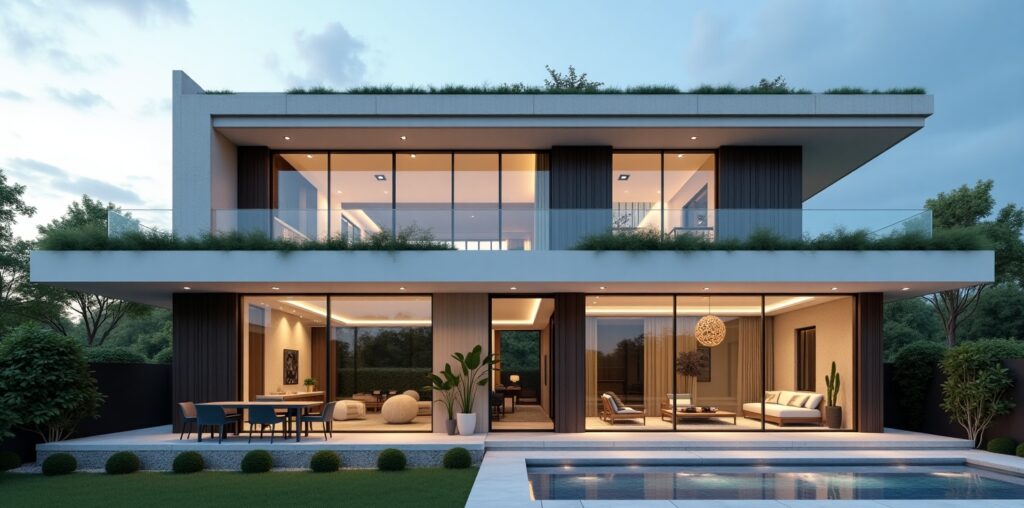Designing a modern home in 2025 requires a combination of aesthetic appeal, functionality, and sustainability. Modern House Projects focus on smart technology, eco-friendly materials, and open-concept living spaces to create homes that are both stylish and practical. Here are the top trends and ideas that will define modern house design in 2025.
1. Sustainable and Eco-Friendly Materials
Sustainability continues to be at the forefront of modern home design. Homeowners are increasingly opting for recycled materials, sustainable wood, and energy-efficient building techniques. Materials like bamboo flooring, reclaimed wood, and low-VOC paints contribute to a healthier environment while maintaining a stylish appeal.
Additionally, passive home design principles, such as maximizing natural light, using thermal mass materials, and integrating green roofs, are becoming more prevalent. These elements help reduce energy consumption while enhancing the home’s aesthetic and functional appeal.
2. Smart Home Integration
Technology is revolutionizing modern home design. Smart home systems, including AI-powered assistants, automated lighting, and security systems, are now standard features. Homeowners can control appliances, lighting, and even heating and cooling systems from their smartphones, enhancing convenience and efficiency.
Moreover, smart kitchens equipped with AI-driven refrigerators and voice-controlled appliances make everyday tasks simpler. As technology continues to advance, expect even more seamless integration between home automation and daily living.
3. Minimalist and Open-Concept Living Spaces
Minimalism remains a defining feature of modern home design. Open-concept layouts that blend the kitchen, dining, and living areas create a spacious and welcoming environment. This design philosophy promotes a clutter-free and functional space, making homes appear larger and more inviting.
Neutral color palettes, clean lines, and multifunctional furniture contribute to the minimalist aesthetic. In 2025, expect to see more built-in storage solutions and hidden compartments that maintain the sleek look while maximizing space.
4. Biophilic Design and Indoor-Outdoor Living
Bringing nature indoors is a growing trend in modern home design. Biophilic design incorporates natural elements such as indoor gardens, large windows with outdoor views, and water features to create a calming and refreshing atmosphere.
Homes in 2025 will feature more seamless transitions between indoor and outdoor spaces. Expansive glass doors, outdoor kitchens, and patio areas designed for year-round use are becoming increasingly popular. These elements promote well-being and make homes feel more connected to nature.
5. Sustainable and Energy-Efficient Features
Energy efficiency is no longer a luxury—it’s a necessity. Solar panels, energy-efficient windows, and smart thermostats are some of the most sought-after features in modern homes. Homeowners are also investing in battery storage systems to make the most of their renewable energy sources.
Geothermal heating and cooling systems, rainwater harvesting, and greywater recycling are additional sustainable options gaining traction. These technologies reduce utility costs and lessen the home’s environmental impact.
6. Bold and Personalized Interior Designs
While minimalism dominates, bold interior designs are also making a statement. Homeowners are incorporating unique textures, statement lighting, and bold accent walls to personalize their living spaces.
Textures like fluted wood paneling, terrazzo flooring, and sculptural furniture add depth and character to modern homes. Expect to see a mix of bold colors like deep blues, emerald greens, and warm terracottas used strategically to add vibrancy without overwhelming the space.
7. Multifunctional and Flexible Spaces
With the rise of remote work and flexible lifestyles, homes are being designed with multifunctional spaces. Home offices, workout areas, and guest rooms that serve multiple purposes are essential in modern home design.
Furniture that can be adapted for different uses, such as fold-away desks and modular sofas, helps optimize space. The demand for adaptable interiors will continue to grow as more people seek versatility in their living environments.
8. Smart Storage Solutions
Decluttering is key to achieving a modern and clean home design. Hidden storage solutions, built-in shelving, and under-stair storage make the most of every inch of space. Walk-in closets with smart organization systems are also a must-have feature in modern homes.
Innovative kitchen storage, such as pull-out pantry shelves and built-in spice racks, helps keep spaces tidy and functional. Maximizing storage while maintaining a sleek aesthetic is a top priority for modern home designers.
Conclusion
Designing a modern home in 2025 is all about balancing aesthetics, technology, and sustainability. By incorporating eco-friendly materials, smart home features, open-concept layouts, and biophilic elements, homeowners can create stylish yet functional living spaces that align with future trends.



